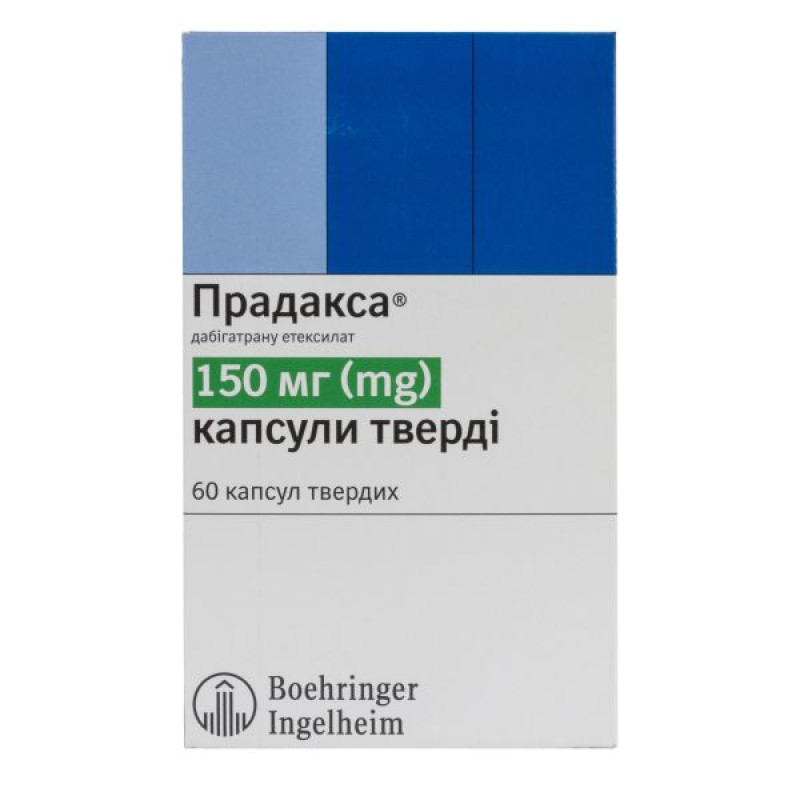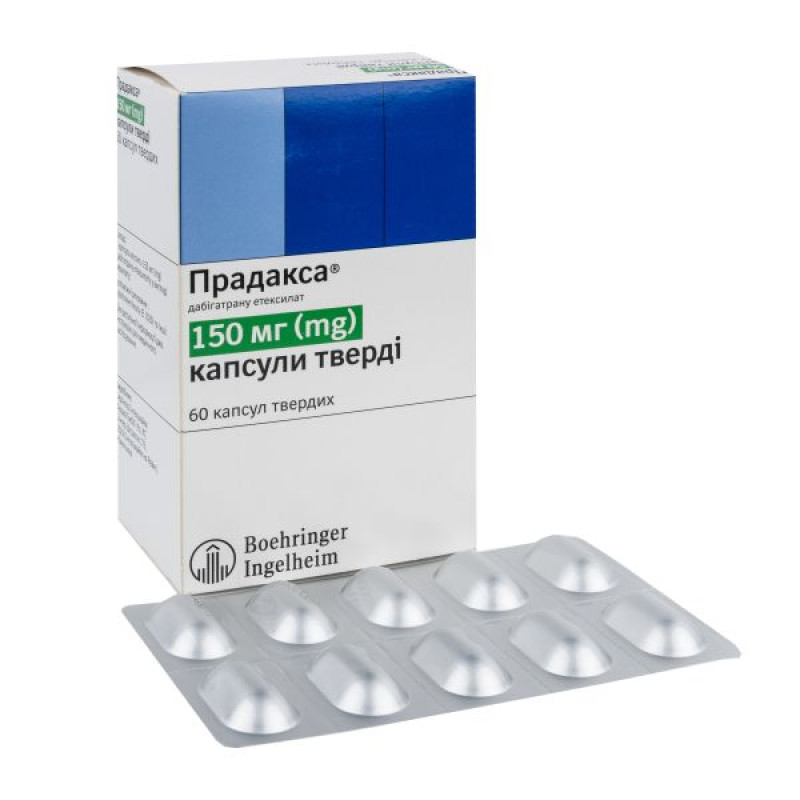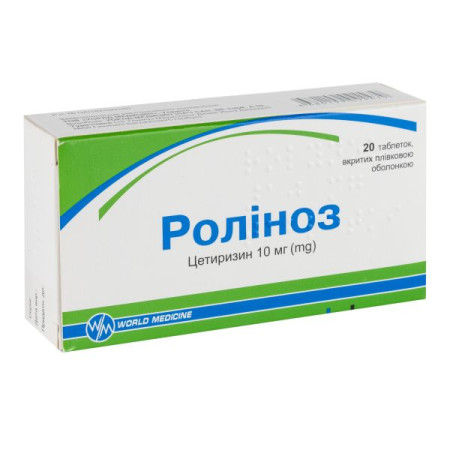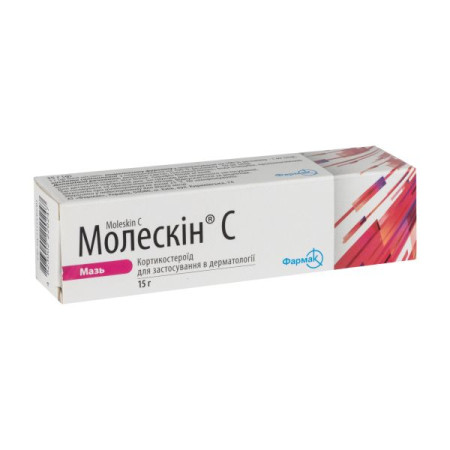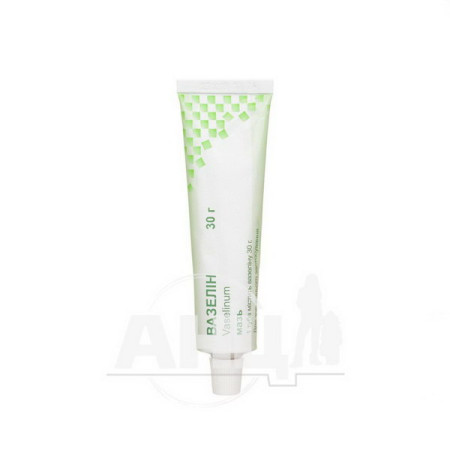Pradaxa hard capsules 150 mg blister No. 60
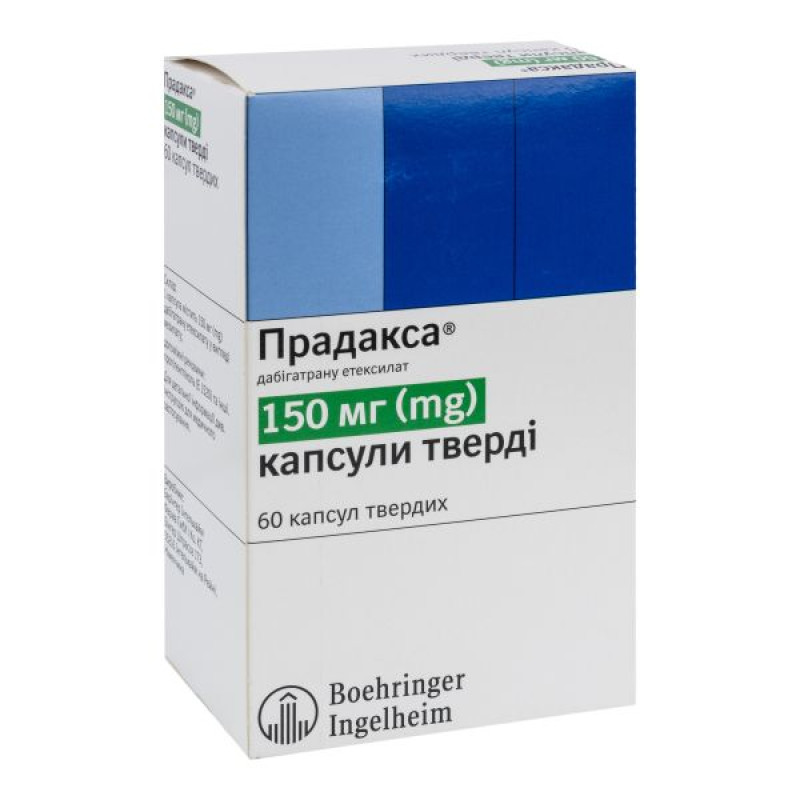
Instructions for Pradaxa hard capsules 150 mg blister No. 60
Composition
active ingredient: dabigatran etexilate;
1 capsule contains 150 mg of dabigatran etexilate as mesylate;
excipients: acacia, tartaric acid, hypromellose, dimethicone, talc, hydroxypropylcellulose;
capsule shell: carrageenan (E 407), potassium chloride, titanium dioxide (E 171), indigo carmine (E 132), hypromellose, purified water;
inscription on the capsule in black ink SW-9008: shellac, butyl alcohol, isopropyl alcohol, black iron oxide (E 172), purified water, propylene glycol (E 1520), anhydrous ethyl alcohol, concentrated ammonium solution, potassium hydroxide.
Dosage form
The capsules are hard.
Main physicochemical properties: Hydroxypropylmethylcellulose capsules (size 0) with an opaque light blue cap with a black Boehringer Ingelheim company symbol and an opaque white capsule body with a black symbol “R150” containing yellowish pellets.
Pharmacotherapeutic group
Antithrombotic agents. Direct thrombin inhibitors.
ATX code B01A E07.
Pharmacological properties
Pharmacodynamics
Mechanism of action: Dabigatran etexilate is a low molecular weight prodrug that does not exhibit pharmacological activity. After oral administration, dabigatran etexilate is rapidly absorbed and converted to dabigatran by esterase-catalyzed hydrolysis in plasma and liver. Dabigatran is a potent competitive reversible direct thrombin inhibitor and the main active substance in plasma.
Since thrombin (a serine protease) activates the conversion of fibrinogen to fibrin in the blood coagulation system, its inhibition prevents the development of a thrombus. Dabigatran also inhibits free thrombin, fibrin-bound thrombin, and thrombin-induced platelet aggregation.
Pharmacodynamic effects: There is a clear correlation between the plasma concentration of dabigatran and the degree of anticoagulant effect based on studies. Dabigatran prolongs thrombin time (TT), clotting time (CTT) and activated partial thromboplastin time (APTT).
The quantitative calibrated diluted thrombin time (cTT) test provides an approximate value for the dabigatran plasma concentration that can be compared with the expected value. If the cTT test result is at or below the limit of quantification, additional coagulation tests (TT, EC, and APTT) should be considered.
The PKI test can provide a direct measurement of the activity of direct thrombin inhibitors.
The aPTT test is widely used and provides an approximate indication of the anticoagulant intensity achieved by dabigatran. However, the aPTT test has limited sensitivity and is not suitable for precise quantification of the anticoagulant effect, especially at high plasma concentrations of dabigatran. Although high aPTT values should be interpreted with caution, they indicate an anticoagulant effect in the patient.
Clinical efficacy and safety.
Ethnic origin
No clinically important ethnic differences were observed among patients who are Caucasian, African American, Hispanic, Japanese, or Chinese.
Patients undergoing catheter ablation for atrial fibrillation. A prospective, open-label, randomized, multicenter, blinded, centrally adjudicated endpoint exploratory trial (RE-CIRCUIT) was conducted in 704 patients on stable anticoagulation therapy. The trial compared continuous dabigatran etexilate 150 mg twice daily with continuous INR-corrected warfarin therapy in patients undergoing catheter ablation for paroxysmal or permanent atrial fibrillation. Of the 704 patients enrolled, 317 underwent catheter ablation for atrial fibrillation while on continuous dabigatran therapy and 318 while on continuous warfarin therapy. All patients underwent transesophageal echocardiography (TEE) prior to catheter ablation. The primary endpoint (ISTH major bleeding) was met by 5 (1.6%) patients in the dabigatran etexilate group and 22 (6.9%) patients in the warfarin group (risk difference -5.3%; 95% CI -8.4, -2.2; P = 0.0009). There were no cases of stroke/systemic embolism/TIA in the dabigatran etexilate group, whereas there was one case of TIA in the warfarin group from the time of ablation to 8 weeks after ablation. This exploratory study showed that dabigatran etexilate was associated with a significant reduction in major bleeding compared with INR-corrected warfarin therapy at ablation.
Data from non-interventional studies
A non-interventional study (GLORIA-AF) prospectively (during the second phase) collected safety and efficacy data in patients with newly diagnosed non-valvular atrial fibrillation (NAF) treated with dabigatran etexilate in real-life settings. The study included 4859 patients treated with dabigatran etexilate (55% received a dose of 150 mg twice daily, 43% - 110 mg twice daily, 2% - 75 mg twice daily). Patients were followed for 2 years. The mean CHADS2 and HAS-BLED scores were 1.9 and 1.2, respectively. The mean follow-up period during treatment was 18.3 months. Major bleeding occurred in 0.97 cases per 100 patient-years. Life-threatening bleeding was reported in 0.46 cases per 100 patient-years, intracranial bleeding in 0.17 cases per 100 patient-years, and gastrointestinal bleeding in 0.60 cases per 100 patient-years. Stroke was observed in 0.65 cases per 100 patient-years.
In addition, during a non-interventional study [Graham DJ et al., Circulation. 2015;131:157-164] in more than 134,000 elderly patients with nonvalvular atrial fibrillation (NAF) in the United States (equivalent to more than 37,500 patient-years of observation on therapy), dabigatran etexilate (84% of patients receiving 150 mg twice daily, 16% of patients receiving 75 mg twice daily) was associated with a reduced risk of ischemic stroke (hazard ratio 0.80, 95% confidence interval [CI] 0.67–0.96), intracranial hemorrhage (hazard ratio 0.34, CI 0.26–0.46), and mortality (hazard ratio 0.86, CI 0.77–0.96), as well as an increased risk of gastrointestinal bleeding (hazard ratio 1.28, CI 1.14–1.44) compared with warfarin. There was no difference in the risk of major bleeding (hazard ratio 0.97, CI 0.88–1.07).
These real-life observations are consistent with the safety and efficacy profile of dabigatran etexilate established in the RE-LY study when used in this indication.
Patients who underwent percutaneous coronary angioplasty (PCA) with stenting
The primary endpoint was achieved in 15.4% (151 patients) in the dual therapy group with dabigatran etexilate 110 mg compared with 26.9% (264 patients) in the triple therapy group with warfarin (HR 0.52; 95% CI 0.42, 0.63; P<0.0001 for non-inferiority and P<0.0001 for superiority) and in 20.2% (154 patients) in the dual therapy group with dabigatran etexilate 150 mg compared with 25.7% (196 patients) in the corresponding triple therapy group with warfarin (HR 0.72; 95% CI 0.58, 0.88; P<0.0001 for non-inferiority and P=0.002 for higher efficiency). In a descriptive analysis, the incidence of major bleeding according to the TIMI (thrombolysis in myocardial infarction) scale was lower in both dual therapy groups with dabigatran etexilate than in the triple therapy group with warfarin: 14 events (1.4%) in the dual therapy group with dabigatran etexilate 110 mg compared with 37 events (3.8%) in the triple therapy group with warfarin (HR 0.37; 95% CI 0.20, 0.68; P=0.002) and 16 events (2.1%) in the dual therapy group with dabigatran etexilate 150 mg compared with 30 events (3.9%) in the corresponding triple therapy group with warfarin (HR 0.51; 95% CI 0.51, 0.68; P=0.002). 0.28, 0.93; P=0.03). Both dabigatran etexilate dual therapy groups had a lower incidence of intracranial hemorrhage than the corresponding warfarin triple therapy group: 3 events (0.3%) in the 110 mg dabigatran etexilate dual therapy group compared with 10 events (1.0%) in the warfarin triple therapy group (HR 0.30; 95% CI 0.08, 1.07; P=0.06) and 1 event (0.1%) in the 150 mg dabigatran etexilate dual therapy group compared with 8 events (1.0%) in the corresponding warfarin triple therapy group (HR 0.12; 95% CI 0.02, 0.98; P=0.06). P=0.047). The combined efficacy endpoint of death, thromboembolic events (myocardial infarction, stroke, and systemic embolism), or unplanned revascularization was noninferior to the warfarin triple therapy group in both dabigatran etexilate dual therapy groups (13.7% vs. 13.4%, respectively; HR 1.04; 95% CI 0.84, 1.29; P=0.0047 for noninferiority). There were no statistical differences in the individual components of the efficacy endpoints between either dabigatran etexilate dual therapy group and the warfarin triple therapy group.
Clinical trials on the prevention of thromboembolism in patients with mechanical heart valves
In clinical studies in patients who had recently undergone mechanical heart valve replacement surgery (e.g. during inpatient treatment) and patients who had undergone mechanical heart valve replacement surgery more than 3 months previously, an increase in thromboembolic complications (mainly strokes and prosthetic valve thrombosis with clinical manifestations and/or asymptomatic) and more bleeding events were observed with dabigatran etexilate compared to warfarin. In patients in the early postoperative period, massive bleeding mainly manifested as hemorrhagic exudate in the pericardial cavity, especially in patients who started dabigatran etexilate (e.g. on day 3) after heart valve replacement surgery (see section "Contraindications").
Pharmacokinetics
After oral administration of dabigatran etexilate, it is rapidly and completely converted to dabigatran, which is the active form in plasma. The conversion of the prodrug dabigatran etexilate by esterase-catalyzed hydrolysis to the active substance dabigatran is the dominant metabolic reaction. The absolute bioavailability of dabigatran after oral administration of dabigatran etexilate was approximately 6.5%.
After oral administration of dabigatran etexilate, the pharmacokinetic profile of dabigatran in plasma is characterized by a rapid increase in concentration, reaching Cmax 0.5–2 hours after administration.
Absorption. The postoperative absorption of dabigatran etexilate, estimated in the study at 1–3 hours after surgery, was relatively low compared to that in healthy volunteers, showing a smooth AUC profile without high peak plasma concentrations. Peak plasma concentrations are reached 6 hours after administration in the postoperative period due to concomitant factors such as anesthesia, gastrointestinal paresis and surgery, regardless of the oral formulation of the drug. An additional study showed that slow and prolonged absorption is usually present only on the day of surgery. On subsequent days, absorption of dabigatran is rapid, with peak plasma concentrations reached 2 hours after administration.
Food does not affect the bioavailability of dabigatran etexilate, but delays the time to reach maximum plasma concentration by 2 hours.
Cmax and AUC were dose proportional.
Distribution: Low (34–35%) concentration-independent binding of dabigatran to human plasma proteins was observed. The volume of distribution of dabigatran, 60–70 L, exceeded the total body fluid volume, indicating moderate tissue distribution of dabigatran.
Biotransformation. The metabolism and elimination of dabigatran were studied after a single intravenous dose of radiolabeled dabigatran to healthy men. After intravenous administration, radioactive dabigatran was mainly excreted in the urine (85%). Faecal excretion accounted for 6% of the administered dose. Recovery of baseline radioactivity to 88–94% occurred 168 hours after dabigatran administration. Dabigatran is conjugated to form pharmacologically active acylglucuronides. There are four positional isomers, 1-O, 2-O, 3-O, 4-O-acylglucuronides, each of which accounts for less than 10% of total dabigatran in plasma. Traces of other metabolites can only be detected by highly sensitive analytical methods. Dabigatran is mainly excreted unchanged in the urine at a rate of approximately 100 ml/min, which corresponds to the glomerular filtration rate.
Breeding
Dabigatran plasma concentrations decline biexponentially with a mean terminal half-life of 11 hours in healthy elderly volunteers. After multiple doses, the terminal half-life was approximately 12–14 hours. The half-life is independent of dose. The half-life is prolonged with decreasing renal function (see Table 1).
Special patient groups.
Renal impairment: In phase I studies, the distribution (AUC) of dabigatran after oral administration was approximately 2.7 times higher in volunteers with moderate renal impairment (creatinine clearance 30-50 ml/min) compared to that in volunteers without renal impairment. In a small number of volunteers with severe renal impairment (creatinine clearance 10-30 ml/min), the AUC of dabigatran was approximately 6 times higher and the half-life was approximately 2 times longer compared to those in volunteers without renal impairment (see sections 4.2, 4.3 and 4.4).
Table 1. Dabigatran half-life depending on renal function
Glomerular filtration rate (creatinine clearance), ml/min | Half-life, hours (gCV %; range) |
| ≥ 80 | 13.4 (25.7%; 11.0–21.6) |
| ≥ 50 – < 80 | 15.3 (42.7%; 11.7–34.1) |
| ≥ 30 – < 50 | 18.4 (18.5%; 13.3–23.0) |
| < 30 | 27.2 (15.3%; 21.6–35.0) |
In addition, dabigatran exposure (at trough and peak) was evaluated in a prospective, open-label, randomized pharmacokinetic study in patients with non-valvular atrial fibrillation and severe renal impairment (creatinine clearance (CrCl) 15-30 mL/min) receiving dabigatran etexilate 75 mg twice daily.
As a result of this regimen, the geometric mean trough concentration measured immediately before the next dose was 155 ng/mL (gCV 76.9%), and the geometric mean peak concentration measured two hours after the last dose was 202 ng/mL (gCV 70.6%).
The clearance of dabigatran during hemodialysis was studied in 7 patients with end-stage renal disease without atrial fibrillation. Dialysis for 4 hours was performed at a dialysate rate of 700 ml/min and a blood flow rate of either 200 ml/min or 350–390 ml/min. This resulted in a 50–60% decrease in dabigatran concentrations, respectively. The amount of substance removed by dialysis is proportional to a blood flow rate of 300 ml/min. The anticoagulant activity of dabigatran decreases with decreasing plasma concentration and did not affect the pharmacodynamic/pharmacokinetics relationship.
Elderly patients: In a phase I dedicated pharmacokinetic study, elderly patients showed an increase in AUC by 40-60% and Cmax by more than 25% compared to young patients. The effect of age on the disposition of dabigatran was confirmed in the RE-LY study: approximately 31% higher concentrations in patients ≥ 75 years of age and approximately 22% lower in patients < 65 years of age compared to patients 65 to 75 years of age (see sections 4.2 and 4.4).
Hepatic impairment: No changes in the disposition of dabigatran were observed in 12 patients with moderate hepatic impairment (Child-Pugh class B) compared to 12 control patients (see sections 4.2 and 4.4).
Body weight: Dabigatran concentrations were approximately 20% lower in patients with a body weight of >100 kg compared to those in patients with a body weight of 50–100 kg. The majority (80.8%) of volunteers were in the ≥50 kg and <100 kg categories with no clear difference (see sections 4.2 and 4.4). Data are limited in the <50 kg category.
Gender: Female patients with atrial fibrillation had an average of 30% higher concentrations during and after administration. No dose adjustment is required (see section 4.2).
Pharmacokinetic interactions: In vitro interaction studies have not shown inhibition or induction of the major cytochrome P450 isoenzymes. This was confirmed by in vitro studies in healthy volunteers, in which no interactions were observed when dabigatran etexilate was treated with the following active substances: atorvastatin (CYP3A4), digoxin (P-gp transporter interaction) and diclofenac (CYP2C9).
Indication
Prevention of stroke and systemic embolism in adult patients with non-valvular atrial fibrillation (NAF) with one or more risk factors such as: previous stroke or transient ischemic attack (TIA), age ≥ 75 years, heart failure (New York Heart Association (NYHA) class ≥ II), diabetes mellitus or hypertension.
Treatment of deep vein thrombosis (DVT) and pulmonary embolism (PE) and prevention of recurrent DVT and PE in adults.
Contraindication
Known hypersensitivity to dabigatran or dabigatran etexilate or to any of the excipients. Severe renal impairment (creatinine clearance < 30 ml/min). Active clinically significant bleeding. Injury or condition considered to be a significant risk factor for major bleeding, including current or recent gastrointestinal ulcer, presence of malignant tumours with high risk of bleeding, recent brain or spinal cord injury, spinal cord or ophthalmic surgery, recent intracerebral haemorrhage, known or suspected oesophageal varices, arteriovenous malformations, vascular aneurysms or significant intraspinal or intracerebral vascular pathologies.
Concomitant use of any anticoagulant medicinal product, such as unfractionated heparin (UFH), low molecular weight heparins (enoxaparin, dalteparin, etc.), heparin derivatives (fondaparinux, etc.), oral anticoagulants (warfarin, rivaroxaban, apixaban, etc.), except in specific circumstances, in particular cases of switching from or to anticoagulant therapy (see section "Method of administration and dosage"), when UFH is used in doses necessary to maintain a patent central venous or arterial catheter, or when UFH is used during catheter ablation for atrial fibrillation (see section "Interaction with other medicinal products and other types of interactions").
Liver dysfunction or liver disease that may affect survival.
Concomitant use with the following strong P-gp inhibitors: systemic ketoconazole, ciclosporin, itraconazole, dronedarone and the fixed-dose combination of glecaprevir/pibrentasvir (see section “Interaction with other medicinal products and other forms of interaction”).
Artificial heart valve requiring anticoagulant therapy.
Interaction with other medicinal products and other types of interactions
Transporter interactions.
Dabigatran etexilate is a substrate for the P-gp transporter. Concomitant use of P-gp inhibitors (see Table 2) is expected to increase dabigatran plasma concentrations.
Unless otherwise stated, close clinical monitoring (for signs of bleeding or anemia) is recommended when dabigatran is used concomitantly with strong P-gp inhibitors. A dose reduction of dabigatran may be required when used in combination with some P-gp inhibitors (see sections 4.2, 4.4, 4.5 and 5.1).
Table 2. Transporter interactions
When dabigatran etexilate was co-administered with a single 600 mg dose of amiodarone, the extent and rate of absorption of amiodarone and its active metabolite diethanolamine (DEA) were not significantly altered. The area under the concentration-time curve (AUC) and Cmax were increased approximately 1.6-fold and 1.5-fold, respectively. Given the long half-life of amiodarone, the potential for interaction may persist for several weeks after discontinuation of amiodarone (see sections 4.2 and 4.4).
Quinidine was administered at a dose of 200 mg every 2 hours up to a total dose of 1000 mg. Dabigatran etexilate was administered twice daily for 3 days, with or without quinidine on day 3. The AUCτ,ss and Cmax,ss of dabigatran were increased overall by 1.53-fold and 1.56-fold, respectively, when quinidine was administered concomitantly (see sections 4.2 and 4.4).
| P-gp inhibitors | |
| Concomitant use is contraindicated (see Contraindications section). | |
| Ketoconazole | Ketoconazole increases the total AUC0-∞ and Cmax of dabigatran by 2.38-fold and 2.35-fold, respectively, after a 400 mg oral dose and by 2.53-fold and 2.49-fold, respectively, after multiple oral doses of 400 mg ketoconazole once daily. |
| Dronedarone | When dabigatran etexilate and dronedarone were co-administered, the total AUC0-∞ and Cmax values of dabigatran were increased approximately 2.4-fold and 2.3-fold, respectively, after multiple doses of 400 mg dronedarone twice daily and approximately 2.1-fold and 1.9-fold, respectively, after a single dose of 400 mg. |
| Itraconazole, cyclosporine | Based on in vitro results, an effect similar to that seen with ketoconazole can be expected. |
| Co-administration of dabigatran etexilate with the fixed-dose combination of P-gp inhibitors glecaprevir/pibrentasvir increases the exposure of dabigatran and may increase the risk of bleeding. | |
| Concomitant use is not recommended. | |
| Tacrolimus | In vitro, tacrolimus has been shown to have a similar level of P-gp inhibitory effect as itraconazole and ciclosporin. The use of dabigatran etexilate with tacrolimus has not been clinically studied. However, limited clinical data with another P-gp substrate (everolimus) suggest that tacrolimus may inhibit P-gp less than with strong P-gp inhibitors. |
| Precautions to be taken in case of concomitant use (see sections “Method of administration and dosage” and “Special precautions for use”). | |
| Verapamil | When dabigatran etexilate (150 mg) was co-administered with oral verapamil, the Cmax and AUC of dabigatran increased depending on the time of administration and the dosage form of verapamil (see sections 4.2 and 4.4). The greatest effect of dabigatran was observed with the first dose of immediate-release verapamil administered one hour before dabigatran etexilate (approximately 2.8-fold increase in Cmax and approximately 2.5-fold increase in AUC). The effect gradually decreased with prolonged-release verapamil (approximately 1.9-fold increase in Cmax and approximately 1.7-fold increase in AUC) or with multiple doses of verapamil (approximately 1.6-fold increase in Cmax and approximately 1.5-fold increase in AUC). No significant interaction was observed when verapamil was administered 2 hours after dabigatran etexilate (increase in Cmax by approximately 1.1-fold and AUC by approximately 1.2-fold). This is due to complete absorption of dabigatran after 2 hours. |
| Amiodarone | |
| Quinidine | |
| Clarithromycin | Concomitant administration of clarithromycin (500 mg twice daily) with dabigatran etexilate in healthy volunteers resulted in an increase in AUC of approximately 1.19-fold and Cmax of approximately 1.15-fold. |
| Ticagrelor | When a single dose of dabigatran etexilate (75 mg) was co-administered with the highest initial dose of ticagrelor (180 mg), dabigatran AUC and Cmax were increased by 1.73-fold and 1.95-fold, respectively. After multiple doses of ticagrelor (90 mg twice daily), dabigatran exposure was increased by 1.56-fold and 1.46-fold for AUC and Cmax, respectively. Co-administration of the highest starting dose of ticagrelor 180 mg and dabigatran etexilate 110 mg (at steady state) increased dabigatran AUC and Cmax by 1.49-fold and 1.65-fold, respectively, compared to dabigatran etexilate alone. When the highest starting dose of ticagrelor 180 mg was administered 2 hours after dabigatran etexilate 110 mg (at steady state), the increase in dabigatran AUCτ,ss and Cmax,ss was reduced to 1.27-fold and 1.23-fold, respectively, compared to dabigatran etexilate alone. This combination is recommended for initiating ticagrelor at the highest starting dose. Co-administration of 90 mg ticagrelor twice daily (maintenance dose) with 110 mg dabigatran etexilate increased dabigatran AUCτ,ss and Cmax,ss by 1.26-fold and 1.29-fold, respectively, compared to dabigatran alone. |
| Posaconazole | Posaconazole also inhibits P-gp to some extent, but has not been clinically studied. Caution should be exercised when PRADAXA is co-administered with posaconazole. |
| P-gp inducers | |
| Concomitant use should be avoided. | |
| Rifampicin, St. John's wort extract (Hypericum perforatum), carbamazepine, or phenytoin | Concomitant use should be avoided due to possible reduction in dabigatran concentrations. Overdose of rifampicin at a dose of 600 mg once daily for 7 days reduced the total Cmax of dabigatran and the total distribution by 65.5 and 67%, respectively. The inducing effect was reduced, resulting in a distribution of dabigatran close to standard by day 7 after cessation of rifampicin therapy. No further increase in bioavailability was observed after the next 7 days. |
| Protease inhibitors such as ritonavir | |
| Concomitant use is not recommended. | |
| Ritonavir and its combinations with other protease inhibitors | Affect P-gp (both as inhibitors and inducers). They have not been studied and are therefore not recommended for concomitant use with PRADAXA. |
| P-gp substrate | |
| Digoxin | In a study conducted in 24 healthy volunteers, no changes in digoxin exposure or clinically significant changes in the disposition of dabigatran were observed when PRADAXA was co-administered with digoxin. |
Medicinal products that have not been studied or for which experience is limited and medicinal products that may increase the risk of bleeding when used concomitantly with PRADAXA: anticoagulants such as unfractionated heparin (UFH), low molecular weight heparins (LMWH) and heparin derivatives (fondaparinux, desirudin), thrombolytics and vitamin K antagonists, rivaroxaban and other oral anticoagulants (see section "Contraindications"), medicinal products that counteract platelet aggregation such as GPIIb/IIIa receptor antagonists, ticlopidine, prasugrel, ticagrelor, dextran and sulfinpyrazone (see section "Special instructions").
According to limited data from the RE-LY study, in patients with atrial fibrillation, concomitant use of other oral or parenteral anticoagulants with dabigatran exilate and warfarin increases the incidence of major bleeding by approximately 2.5-fold, mainly when switching from one anticoagulant to another (see section 4.3).
UFH can be used in doses necessary to maintain a patent central venous or arterial catheter, or during catheter ablation for atrial fibrillation (see section "Contraindications").
Table 3. Interaction with anticoagulants and drugs that counteract platelet aggregation.
Research data suggest that concomitant use of 81 mg and 325 mg of acetylsalicylic acid (ASA) with dabigatran etexilate 150 mg twice daily may increase the risk of major bleeding from 12% to 18% and 24%, respectively (see section 4.4).
| Nonsteroidal anti-inflammatory drugs (NSAIDs) | Short-term use of NSAIDs for perioperative analgesia was not associated with an increased risk of bleeding when used concomitantly with dabigatran etexilate. Long-term use of NSAIDs with dabigatran etexilate and warfarin increased the risk of bleeding by approximately 50% in a study. |
| Clopidogrel | In a study in young healthy male volunteers, co-administration of dabigatran etexilate and clopidogrel did not prolong capillary bleeding time compared to clopidogrel alone. In addition, dabigatran AUCτ,ss and Cmax,ss and the effect of dabigatran on platelet aggregation inhibition were unchanged compared to those of combination therapy and the respective monotherapy. At doses of 300 mg or 600 mg of clopidogrel, dabigatran AUCτ,ss and Cmax,ss increased by approximately 30–40% (see section 4.4). |
| Acetylsalicylic acid | |
| Low molecular weight heparins | The concomitant use of low molecular weight heparins such as enoxaparin and dabigatran etexilate has not been studied. After switching from a 3-day treatment with enoxaparin 40 mg once daily 24 hours after the last dose of enoxaparin, dabigatran exposure was slightly lower than after administration of dabigatran etexilate alone (single dose of 220 mg). Higher anti-FXa/FIIa activity was observed after administration of dabigatran etexilate with pre-treatment with enoxaparin compared to treatment with dabigatran etexilate alone. This is due to the pre-treatment with enoxaparin and is not clinically relevant. Pre-treatment with enoxaparin did not affect other anticoagulation tests of dabigatran. |
Table 4. Other interactions
| Selective serotonin reuptake inhibitors (SSRIs), selective norepinephrine reuptake inhibitors (SNRIs) | |
| Selective serotonin reuptake inhibitors (SSRIs), selective norepinephrine reuptake inhibitors (SNRIs) | SSRIs and SNRIs increased the risk of bleeding during the study in all treatment groups. |
| Substances that affect gastric pH | |
| Pantoprazole | Concomitant administration of PRADAXA and pantoprazole resulted in a 30% decrease in dabigatran AUC. Pantoprazole and other proton pump inhibitors (PPIs) have been used concomitantly with PRADAXA in clinical studies. Concomitant use of PPIs did not reduce the efficacy of PRADAXA. |
| Ranitidine | Concomitant use of ranitidine and PRADAXA had no clinically relevant effect on the extent of dabigatran absorption. |
Interactions related to the metabolic profile of dabigatran etexilate and dabigatran.
Dabigatran etexilate and dabigatran are not metabolised by the cytochrome P450 system and have no effect on cytochrome P450 enzymes in vitro. Therefore, no interactions of dabigatran etexilate or dabigatran with medicinal products metabolised by the cytochrome P450 system are expected.
Application features
In life-threatening situations or uncontrolled bleeding, when rapid reversal of the anticoagulant effect is required, a specific reversal agent, PRAXBY, is used.
There are no reviews for this product.
There are no reviews for this product, be the first to leave your review.
No questions about this product, be the first and ask your question.







